xray tube/ beam intensity
1/60
There's no tags or description
Looks like no tags are added yet.
Name | Mastery | Learn | Test | Matching | Spaced |
|---|
No study sessions yet.
61 Terms
Added Filtration: required by law
How it works
reduced by [...]
Absorber placed in path of exiting X-Rays
Aluminum is an excellent filter for low energy radiation
photoelectric reactions
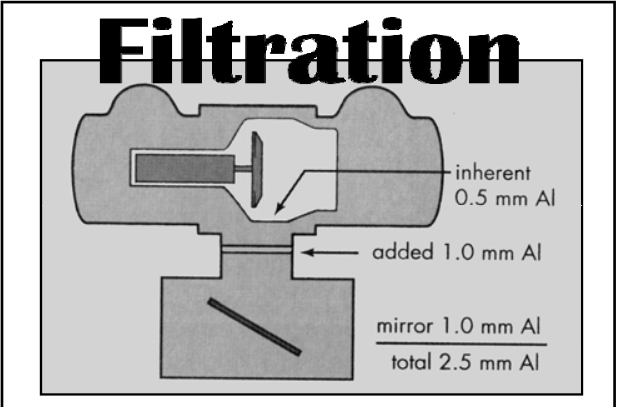
Added Filtration: required by law
How it works
reduced by photoelectric reactions
Absorber placed in path of exiting X-Rays
Aluminum is an excellent filter for [high or low] energy radiation
low
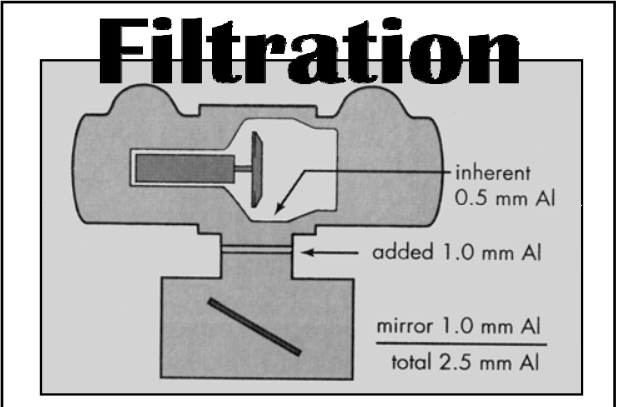
Added Filtration: required by law
Measured in actual or equivalent aluminum thickness
50 to 70 kVp range requires [...] mm total Al filtration
[...] added
1.5
0.5
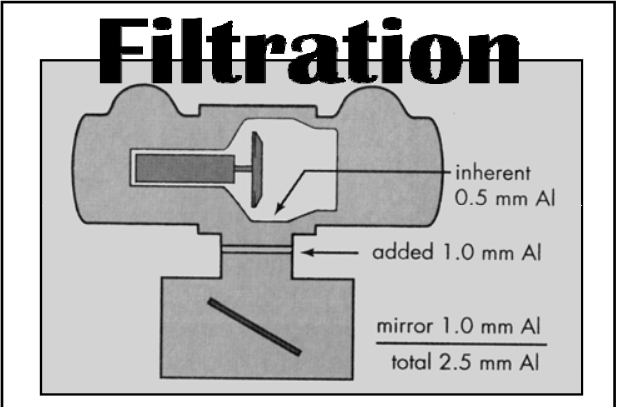
Anode Heel effect: x-ray beam intensity is not uniform
Heel effect [increases or decreases] with decreasing anode angels
increases
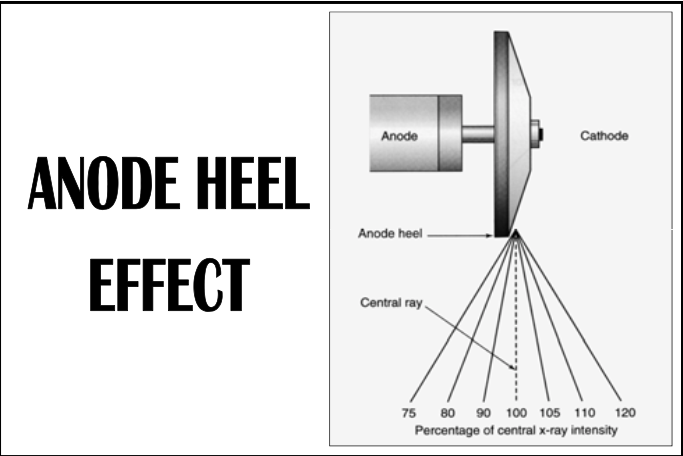
Anode Heel effect: x-ray beam intensity is not uniform
Higher intensity is on the cathode side
Consequently, [thick or thin] body parts should be positioned toward the cathode
thicker
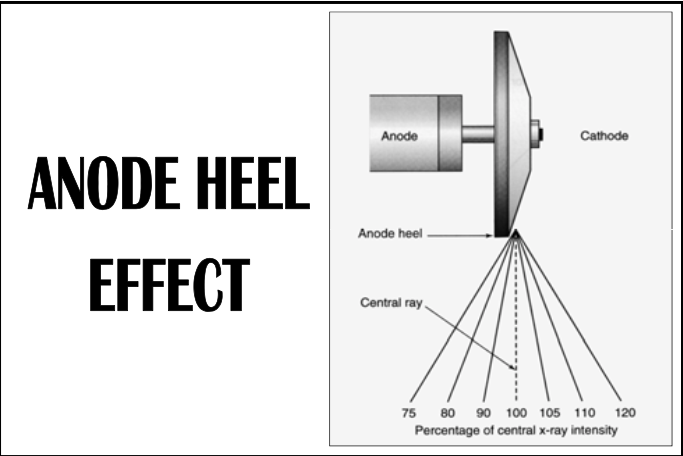
Anode Tungsten Target
[...]: target area bombarded by electrons
[...]: area/shape of beam projected onto the patient
Angling the anode target creates an effective focal spots that is much smaller than the focal spot (thus producing sharper image
Focal Spot
Effective Focal Spot
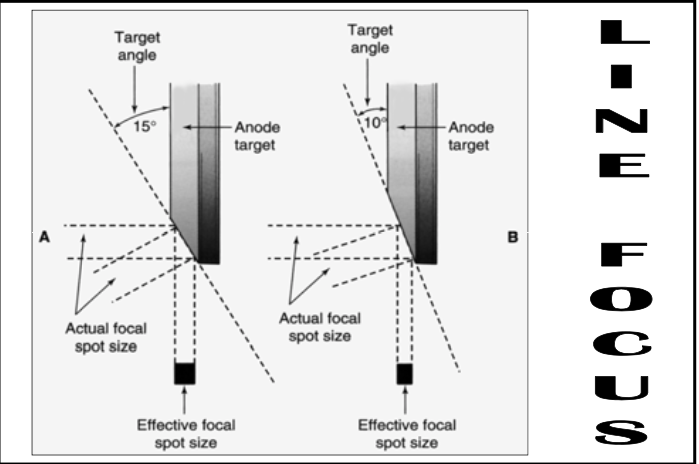
![<p>Binding Energy Review</p><ul><li><p>Bound particles always have a <span><strong>[positive or negative]</strong></span> potential energy</p></li><li><p>To free electron from an atom, energy must be raised to zero or a positive value </p></li></ul><p></p>](https://knowt-user-attachments.s3.amazonaws.com/792155bd-e9b4-4d2f-893a-cad411e59b08.png)
Binding Energy Review
Bound particles always have a [positive or negative] potential energy
To free electron from an atom, energy must be raised to zero or a positive value
negative

![<p>Bremsstrahlung Radiation (“Braking” Radiation)</p><ul><li><p>Angle of deflection is random & electrons can penetrate through many anode layers before it is forced to change direction</p></li><li><p>As a result, <span><strong>[what?]</strong></span></p></li></ul><p></p>](https://knowt-user-attachments.s3.amazonaws.com/72e291ae-a6fa-424a-adb1-a7fdae0e2672.png)
Bremsstrahlung Radiation (“Braking” Radiation)
Angle of deflection is random & electrons can penetrate through many anode layers before it is forced to change direction
As a result, [what?]
exiting photons have many different energy values (they’re polyenergetic)
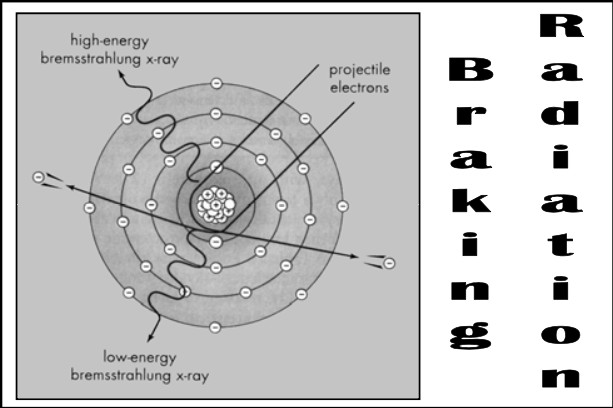
Bremsstrahlung Radiation (“Braking” Radiation)
Each deflection yields a [...] of radiation
photon

Cathodes
Current applied to [...]
Attains a very high temperature (this is why tungsten is chosen bc it has a very high melting point so it can take the heat)
Units in Amps (A)
tungsten filament
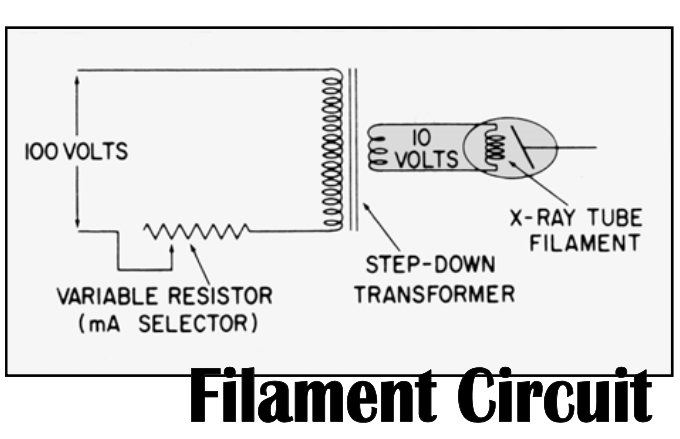
Cathodes
Current applied to tungsten filament
Attains a very high temperature (this is why tungsten is chosen bc it has a very high melting point so it can take the heat)
Units in [...]
Amps (A)

Cathodes
Filament Circuit
Voltage across filament is [...]
Current across filament is [...]
(higher current than the X-Ray tube, which has low current in mA & high voltage)
Power dissipated is [...]
10 V
4A
40W
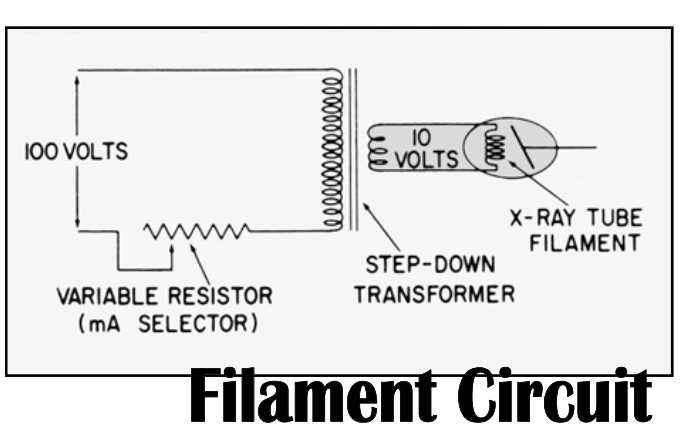
Cathodes
[...] surrounds the filament coil
Function: aiming device
As the negative electrons are emitted from the tungsten coil, they’re repelled by negative EN of the focusing cup, which allows the beam to narrow and target the positive anode target
Focusing cup

![<p>Cathodes</p><ul><li><p><span>Focusing cup</span> surrounds the filament coil<br></p><ul><li><p>Function: <span><strong>[...]</strong></span></p><ul><li><p><span>As the <strong>negative</strong> electrons are emitted from the tungsten coil, they’re repelled by <strong>negative</strong> EN of the focusing cup, which allows the beam to narrow and target the <strong>positive</strong> anode target</span> </p></li></ul></li></ul></li></ul><p></p>](https://knowt-user-attachments.s3.amazonaws.com/a01ed956-a896-45e5-9ed5-2aa4f0261a5c.png)
Cathodes
Focusing cup surrounds the filament coil
Function: [...]
As the negative electrons are emitted from the tungsten coil, they’re repelled by negative EN of the focusing cup, which allows the beam to narrow and target the positive anode target
aiming device
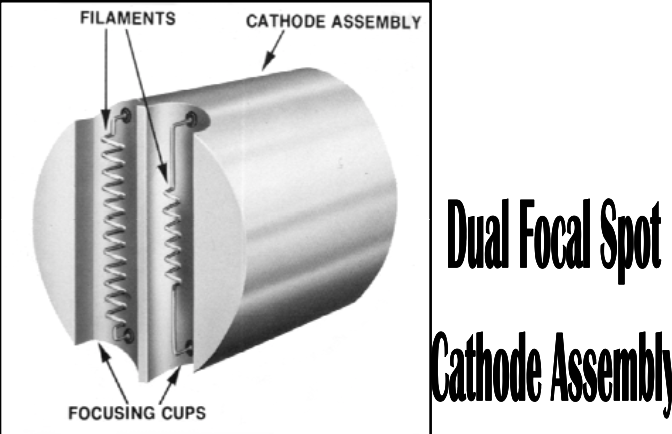
![<p>Cathodes</p><ul><li><p><span>Focusing cup</span> surrounds the filament coil<br></p><ul><li><p>Function: <span>aiming device</span></p><ul><li><p><span><strong>[but how?]</strong></span> </p></li></ul></li></ul></li></ul><p></p>](https://knowt-user-attachments.s3.amazonaws.com/9e3cb9d5-8b60-4787-8d8c-5491d69a1936.png)
Cathodes
Focusing cup surrounds the filament coil
Function: aiming device
[but how?]
As the negative electrons are emitted from the tungsten coil, they’re repelled by negative EN of the focusing cup, which allows the beam to narrow and target the positive anode target
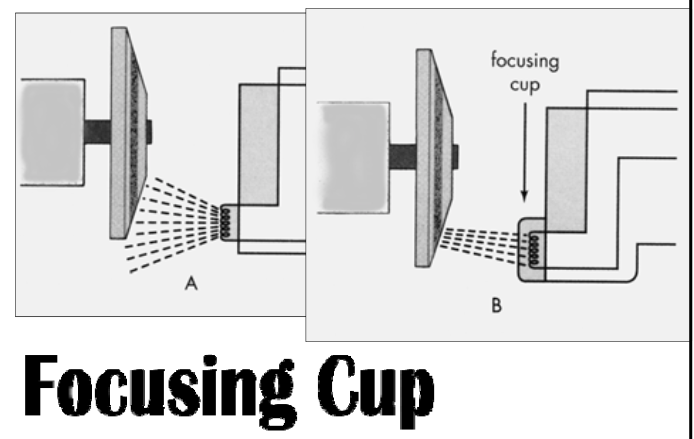
Cathodes
[...]
High resistance in the filament causes temperature to rise > 2200 deg C
Electrons “boil-off” or ionization from the tremendous heat and form a negatively charged electron cloud that will be attracted to the positive anode
Thermionic Emission
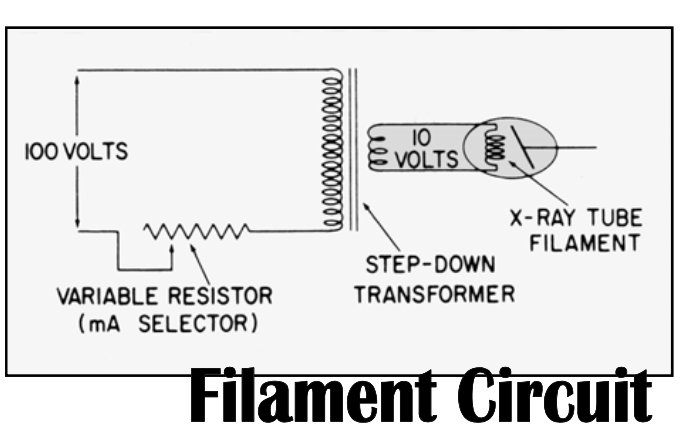
![<p>Cathodes</p><ul><li><p><span>Thermionic Emission</span><br></p><ul><li><p>High resistance in the filament causes temperature to rise > 2200 deg C</p></li><li><p>Electrons “boil-off” or ionization from the tremendous heat and form a <span><strong>[...]</strong></span> that will be attracted to the positive anode </p></li></ul></li></ul><p></p>](https://knowt-user-attachments.s3.amazonaws.com/625402fe-f755-4a96-9128-25de43e5365c.png)
Cathodes
Thermionic Emission
High resistance in the filament causes temperature to rise > 2200 deg C
Electrons “boil-off” or ionization from the tremendous heat and form a [...] that will be attracted to the positive anode
negatively charged electron cloud
![<p>Characteristic Radiation</p><ul><li><p>As we <span><strong>[do what]</strong></span>, we increase the probability that a K shell electron will be knocked out so that 10 to 28% of x-rays are due to characteristic radiation </p></li></ul><p></p>](https://knowt-user-attachments.s3.amazonaws.com/5f8d6522-e417-4eaf-a039-996807a9e27c.png)
Characteristic Radiation
As we [do what], we increase the probability that a K shell electron will be knocked out so that 10 to 28% of x-rays are due to characteristic radiation
increase kVP
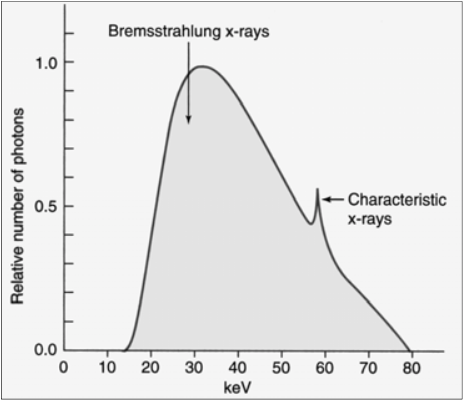
![<p>Characteristic Radiation</p><ul><li><p>Ionized tungsten anode atom returns to its normal energy state by <span><strong>[...]</strong></span><br></p><ul><li><p>Therefore, it <span><strong>[is or is not]</strong></span> polyenergetic </p></li></ul></li></ul><p></p>](https://knowt-user-attachments.s3.amazonaws.com/db5f5d47-b1d4-41f3-84b1-49b395d77d42.png)
Characteristic Radiation
Ionized tungsten anode atom returns to its normal energy state by [...]
Therefore, it [is or is not] polyenergetic
emitting radiation in the x-ray wavelength
is NOT
![<p>Filtration</p><ul><li><p>Filters out <span><strong>[what?]</strong></span></p></li></ul><p></p>](https://knowt-user-attachments.s3.amazonaws.com/23179b09-b631-4ccd-86bb-e19583d93661.png)
Filtration
Filters out [what?]
majority of soft radiation (long wavelength, low energy)
This hardens the beam (bc soft ones have been eliminated
![<p>Filtration</p><ul><li><p>Just 1 mm of aluminum cuts exposure to skin by <span><strong>[...]</strong></span></p></li></ul><p></p>](https://knowt-user-attachments.s3.amazonaws.com/642708cc-ad2f-46fc-a46e-9ee273adece6.png)
Filtration
Just 1 mm of aluminum cuts exposure to skin by [...]
half!
![<p>Filtration</p><ul><li><p>Measured in <span><strong>[what unit]</strong></span> of actual or equivalent aluminum thickness </p></li></ul><p></p>](https://knowt-user-attachments.s3.amazonaws.com/8bf8e0d3-74b0-4e9c-b433-24a7583fa827.png)
Filtration
Measured in [what unit] of actual or equivalent aluminum thickness
millimeters
his hardens the beam (bc soft ones have been eliminated
![<p>Inherent vs Added</p><ul><li><p>Total Filtration = <span><strong>[...]</strong></span> + <span><strong>[...]</strong></span> </p></li></ul><p></p>](https://knowt-user-attachments.s3.amazonaws.com/d68f248e-74dd-4dc0-ac7d-2b633a37fbdc.png)
Inherent vs Added
Total Filtration = [...] + [...]
Added + Inherent
![<p>Inherent: total filtering in every x-ray tube head</p><ul><li><p>About <span><strong>[...]</strong></span> to <span><strong>[...]</strong></span> mm Al Equivalent</p></li><li><p>Results when X-Rays pass through<br></p><ul><li><p><span>Glass envelope</span></p></li><li><p><span>Insulating oil surrounding tube</span></p></li><li><p><span>Window (bakelite, etc.)</span> </p></li></ul></li></ul><p></p>](https://knowt-user-attachments.s3.amazonaws.com/3f5720c6-2c0e-4819-af82-85a0c6137a39.png)
Inherent: total filtering in every x-ray tube head
About [...] to [...] mm Al Equivalent
Results when X-Rays pass through
Glass envelope
Insulating oil surrounding tube
Window (bakelite, etc.)
0.9 to 1.0
![<p>Inherent: total filtering in every x-ray tube head</p><ul><li><p>About <span>0.9</span> to <span>1.0</span> mm Al Equivalent</p></li><li><p>Results when X-Rays pass through<br></p><ul><li><p><span><strong>[...]</strong></span></p></li><li><p><span><strong>[...]</strong></span></p></li><li><p><span><strong>[...]</strong></span> </p></li></ul></li></ul><p></p>](https://knowt-user-attachments.s3.amazonaws.com/0f2ecae4-6c9f-49e0-9ee8-9a879de419ed.png)
Inherent: total filtering in every x-ray tube head
About 0.9 to 1.0 mm Al Equivalent
Results when X-Rays pass through
[...]
[...]
[...]
Glass envelope
Insulating oil surrounding tube
Window (bakelite, etc.)
![<p>Normal Binding shell energies for Tungsten (energetic electron has to equal or be greater than the BE in order for this to happen)</p><ul><li><p>K shell – <span><strong>[...]</strong></span> keV</p></li><li><p>L Shell – <span><strong>[...]</strong></span> keV</p></li><li><p>M Shell – <span><strong>[...]</strong></span> keV </p></li></ul><p></p>](https://knowt-user-attachments.s3.amazonaws.com/0c7bfe1f-e868-4389-9832-c8d56adb1b0b.png)
Normal Binding shell energies for Tungsten (energetic electron has to equal or be greater than the BE in order for this to happen)
K shell – [...] keV
L Shell – [...] keV
M Shell – [...] keV
K shell – 70 keV
L Shell – 11 keV
M Shell – 2 keV
![<p>Rotating vs Stationary Design of Anode</p><ul><li><p>Focal spot is the <span><strong>[same or different?]</strong></span> size in both</p></li><li><p>Rotating Design Benefits<br></p><ul><li><p><span>Increased surface area</span> & <span>better at dissipating heat</span></p><ul><li><p>Motor spins anode to high speed to dissipate heat </p></li></ul></li></ul></li></ul><p></p>](https://knowt-user-attachments.s3.amazonaws.com/a98e15f5-c488-4888-b9be-e2058c6282d8.png)
Rotating vs Stationary Design of Anode
Focal spot is the [same or different?] size in both
Rotating Design Benefits
Increased surface area & better at dissipating heat
Motor spins anode to high speed to dissipate heat
same
![<p>Rotating vs Stationary Design of Anode</p><ul><li><p>Focal spot is the <span>same</span> size in both</p></li><li><p>Rotating Design Benefits<br></p><ul><li><p><span><strong>[...]</strong></span> & <span><strong>[...]</strong></span></p><ul><li><p>Motor spins anode to high speed to dissipate heat </p></li></ul></li></ul></li></ul><p></p>](https://knowt-user-attachments.s3.amazonaws.com/f0bf816c-5824-4989-8c90-45fe83b1755c.png)
Rotating vs Stationary Design of Anode
Focal spot is the same size in both
Rotating Design Benefits
[...] & [...]
Motor spins anode to high speed to dissipate heat
Increased surface area & better at dissipating heat
Three basic Anode Interactions
99% – [...]
0.9% – [...]
0.1% – [...]
99% – Infrared Radiation
0.9% – Bremsstrahlung Radiation
0.1% – Characteristic Radiation
![<p>Two benefits of Tungsten Target</p><ul><li><p><span><strong>[...]</strong></span></p></li><li><p><span><strong>[...]</strong></span> </p></li></ul><p></p>](https://knowt-user-attachments.s3.amazonaws.com/842678b3-e903-4478-8d2e-20deac297d23.png)
Two benefits of Tungsten Target
[...]
[...]
High melting point (3370 deg C)
High atomic number (Z = 74)
High atomic number is important because electrons are in its K shell has a high BE so when releases a lot of energy when the electrons are pried away
![<p>Typical Polyenergetic Bremsstrahlung Curve</p><ul><li><p>Area under the curve is <span><strong>[...]</strong></span></p></li><li><p>Peaks at <span>1/3 of the total kVp</span> that the x-ray machine is set to </p></li><li><p>Spikes on the curve is because of <span>characteristic radiation </span></p></li></ul><p></p>](https://knowt-user-attachments.s3.amazonaws.com/889aab37-d8fc-48f4-a8b6-f3e0e78375a0.png)
Typical Polyenergetic Bremsstrahlung Curve
Area under the curve is [...]
Peaks at 1/3 of the total kVp that the x-ray machine is set to
Spikes on the curve is because of characteristic radiation
the number of photons
![<p>Typical Polyenergetic Bremsstrahlung Curve</p><ul><li><p>Area under the curve is <span>the number of photons</span></p></li><li><p>Peaks at <span><strong>[...]</strong></span> that the x-ray machine is set to </p></li><li><p>Spikes on the curve is because of <span>characteristic radiation </span></p></li></ul><p></p>](https://knowt-user-attachments.s3.amazonaws.com/7ffcc298-6f92-40e3-86c4-028cdd704f9f.png)
Typical Polyenergetic Bremsstrahlung Curve
Area under the curve is the number of photons
Peaks at [...] that the x-ray machine is set to
Spikes on the curve is because of characteristic radiation
1/3 of the total kVp
![<p>Typical Polyenergetic Bremsstrahlung Curve</p><ul><li><p>Area under the curve is <span>the number of photons</span></p></li><li><p>Peaks at <span>1/3 of the total kVp</span> that the x-ray machine is set to </p></li><li><p>Spikes on the curve is because of <span><strong>[...]</strong></span></p></li></ul><p></p>](https://knowt-user-attachments.s3.amazonaws.com/7882082b-fd69-48c2-98e8-c78d98bbdd2b.png)
Typical Polyenergetic Bremsstrahlung Curve
Area under the curve is the number of photons
Peaks at 1/3 of the total kVp that the x-ray machine is set to
Spikes on the curve is because of [...]
characteristic radiation
![<p>Wedge filter – great for the foot</p><ul><li><p>In the foot, the thick part of the wedge should be over the <span><strong>[...]</strong></span> and the thin part of the wedge should be over the <span><strong>[...]</strong></span> </p></li></ul><p></p>](https://knowt-user-attachments.s3.amazonaws.com/2b3d2ff2-c026-44c8-b80c-e1a9f05d8cc4.png)
Wedge filter – great for the foot
In the foot, the thick part of the wedge should be over the [...] and the thin part of the wedge should be over the [...]
toes (which are thin)
dense midfoot
![<p>Wedge filter – great for the foot</p><ul><li><p>Not used all the time because <span><strong>[...]</strong></span> </p></li></ul><p></p>](https://knowt-user-attachments.s3.amazonaws.com/df8c026f-40e0-4490-a32c-daf5caca7566.png)
Wedge filter – great for the foot
Not used all the time because [...]
you’d have to teach every technician (steep learning curve)
![<p>Wedge filter – great for the foot</p><ul><li><p>Thin part of the patient is under the <span><strong>[thin or thick]</strong></span> part of the wedge </p></li></ul><p></p>](https://knowt-user-attachments.s3.amazonaws.com/2960c1ed-6a88-472d-ae4f-d6cdf952b1d7.png)
Wedge filter – great for the foot
Thin part of the patient is under the [thin or thick] part of the wedge
thick
(this way, thin part of the patient doesn’t get the brunt of the radiation)
![<p>Why have wide beam at all then, if narrow beam produces sharper images?</p><ul><li><p><span><strong>[...]</strong></span></p></li><li><p>Also, <span><strong>[...]</strong></span> </p></li></ul><p></p>](https://knowt-user-attachments.s3.amazonaws.com/5d7d13c6-c106-4ed9-91ec-4fac015a554e.png)
Why have wide beam at all then, if narrow beam produces sharper images?
[...]
Also, [...]
Narrow beams only cover a small area so can’t x-ray large areas like the abdomen
the Heel Effect
![<p><span><strong>[...]</strong></span>: x-ray beam intensity is not uniform </p><ul><li><p>X-ray intensity is 100% in the <span>center</span>, called the <span>central ray</span></p></li><li><p>Towards the anode, x-ray intensity <span>decreases</span></p></li><li><p>Towards the cathode, x-ray intensity <span>increases</span></p></li></ul><p></p>](https://knowt-user-attachments.s3.amazonaws.com/32f7a9eb-18a0-49f6-b828-f4c100bb7a5d.png)
[...]: x-ray beam intensity is not uniform
X-ray intensity is 100% in the center, called the central ray
Towards the anode, x-ray intensity decreases
Towards the cathode, x-ray intensity increases
Anode Heel effect
![<p><span>Anode Heel effect</span>: x-ray beam intensity is not uniform </p><ul><li><p>X-ray intensity is 100% in the <span><strong>[...]</strong></span>, called the <span><strong>[...]</strong></span></p></li><li><p>Towards the anode, x-ray intensity <span>decreases</span></p></li><li><p>Towards the cathode, x-ray intensity <span>increases</span></p></li></ul><p></p>](https://knowt-user-attachments.s3.amazonaws.com/c7f6712e-64ed-4819-b5d9-2e5fc2752d57.png)
Anode Heel effect: x-ray beam intensity is not uniform
X-ray intensity is 100% in the [...], called the [...]
Towards the anode, x-ray intensity decreases
Towards the cathode, x-ray intensity increases
center
central ray
![<p><span>Anode Heel effect</span>: x-ray beam intensity is not uniform </p><ul><li><p>X-ray intensity is 100% in the <span>center</span>, called the <span>central ray</span></p></li><li><p>Towards the anode, x-ray intensity <span><strong>[increase or decrease]</strong></span></p></li><li><p>Towards the cathode, x-ray intensity <span><strong>[increase or decrease]</strong></span></p></li></ul><p></p>](https://knowt-user-attachments.s3.amazonaws.com/f00b802d-fbaa-485e-b697-6daf93b4fe9f.png)
Anode Heel effect: x-ray beam intensity is not uniform
X-ray intensity is 100% in the center, called the central ray
Towards the anode, x-ray intensity [increase or decrease]
Towards the cathode, x-ray intensity [increase or decrease]
decreases
increase
[...], tube current is space charge limited
[...], all electrons are pulled away from the filament & tube current is maximized
Tube current is now largely controlled by filament heating
At low kVp (below 40 kVp)
At saturation voltage (40 kVp)
At low kVp (below 40 kVp), tube current is space charge limited
At saturation voltage (40 kVp), all electrons are pulled away from the filament & tube current is maximized
Tube current is now largely controlled by [...]
filament heating
![<p><span><strong>[...]</strong></span></p><ul><li><p>Happens when a very high-energy electron gets really close to the nucleus (through the K Layer) and is diverted by nucleus<br></p><ul><li><p>Change in direction causes energy to be lost. This energy becomes a photon (braking effect)</p></li><li><p>There is NO collision, <strong>simply a change of direction due to opposing nuclear forces</strong> </p></li></ul></li></ul><p></p>](https://knowt-user-attachments.s3.amazonaws.com/438f261c-bb95-4e25-bf24-abb116481255.png)
[...]
Happens when a very high-energy electron gets really close to the nucleus (through the K Layer) and is diverted by nucleus
Change in direction causes energy to be lost. This energy becomes a photon (braking effect)
There is NO collision, simply a change of direction due to opposing nuclear forces
Bremsstrahlung Radiation (“Braking” Radiation)
![<p><span><strong>[...]</strong></span></p><ul><li><p>Electrons bombarding the target is able to knock out one of the inner orbital electrons<br></p><ul><li><p>Possible because <span>incoming electron energy is equal to or greater than the atomic shell binding energy</span> </p></li></ul></li></ul><p></p>](https://knowt-user-attachments.s3.amazonaws.com/628de920-fecb-4110-a1a0-e59c98efb176.png)
[...]
Electrons bombarding the target is able to knock out one of the inner orbital electrons
Possible because incoming electron energy is equal to or greater than the atomic shell binding energy
Characteristic Radiation
![<p><span>Characteristic Radiation</span></p><ul><li><p>Electrons bombarding the target is able to knock out one of the inner orbital electrons<br></p><ul><li><p>Possible because <span><strong>[of what?]</strong></span> </p></li></ul></li></ul><p></p>](https://knowt-user-attachments.s3.amazonaws.com/a92fd8c8-7a29-4874-b391-27ee58394a78.png)
Characteristic Radiation
Electrons bombarding the target is able to knock out one of the inner orbital electrons
Possible because [of what?]
incoming electron energy is equal to or greater than the atomic shell binding energy
![<p><span><strong>[...]</strong></span>: compensate for part density variation </p><ul><li><p>Wedge filter – great for the foot</p></li><li><p>Trough/bilateral wedge filter – great for the chest </p></li></ul><p></p>](https://knowt-user-attachments.s3.amazonaws.com/375a0bea-5b1a-4557-a8a1-b334bd0ff562.png)
[...]: compensate for part density variation
Wedge filter – great for the foot
Trough/bilateral wedge filter – great for the chest
Compensating Filters
![<p><span><strong>[...]</strong></span></p><ul><li><p>Combined layer of <span>Al (Z=13)</span> & <span>Cu (Z=29)</span><br></p><ul><li><p><span>Decreases</span> filter thickness for very high energy beams</p></li><li><p><span>Copper</span> faces X-Ray beam </p></li></ul></li></ul><p></p>](https://knowt-user-attachments.s3.amazonaws.com/2f3fda27-1de1-42a3-b188-29e3667933f2.png)
[...]
Combined layer of Al (Z=13) & Cu (Z=29)
Decreases filter thickness for very high energy beams
Copper faces X-Ray beam
Compound Filter
![<p><span>Compound Filter</span></p><ul><li><p>Combined layer of <span><strong>[...]</strong></span> & <span><strong>[...]</strong></span><br></p><ul><li><p><span>Decreases</span> filter thickness for very high energy beams</p></li><li><p><span>Copper</span> faces X-Ray beam </p></li></ul></li></ul><p></p>](https://knowt-user-attachments.s3.amazonaws.com/add6c95c-814d-4a3d-be48-fc062b8ae556.png)
Compound Filter
Combined layer of [...] & [...]
Decreases filter thickness for very high energy beams
Copper faces X-Ray beam
Al (Z=13) & Cu (Z=29)
![<p><span>Compound Filter</span></p><ul><li><p>Combined layer of <span>Al (Z=13)</span> & <span>Cu (Z=29)</span><br></p><ul><li><p><span><strong>[increases or decrease]</strong></span> filter thickness for very high energy beams</p></li><li><p><span>Copper</span> faces X-Ray beam </p></li></ul></li></ul><p></p>](https://knowt-user-attachments.s3.amazonaws.com/ccb88502-40c3-4a62-bbb5-f5c3a54ba622.png)
Compound Filter
Combined layer of Al (Z=13) & Cu (Z=29)
[increases or decrease] filter thickness for very high energy beams
Copper faces X-Ray beam
Decreases
![<p><span>Compound Filter</span></p><ul><li><p>Combined layer of <span>Al (Z=13)</span> & <span>Cu (Z=29)</span><br></p><ul><li><p><span>Decreases</span> filter thickness for very high energy beams</p></li><li><p><span><strong>[...]</strong></span> faces X-Ray beam </p></li></ul></li></ul><p></p>](https://knowt-user-attachments.s3.amazonaws.com/ca03325f-e05b-4427-a8c0-b77645605746.png)
Compound Filter
Combined layer of Al (Z=13) & Cu (Z=29)
Decreases filter thickness for very high energy beams
[...] faces X-Ray beam
Copper
![<p><span><strong>[...]</strong></span> principle: anode is angled to <span>decrease</span> focal spot size</p><ul><li><p><span>Smaller focal spot</span> = sharper images</p></li><li><p><span>shallow angles</span> = sharper images </p></li></ul><p></p>](https://knowt-user-attachments.s3.amazonaws.com/df97d99b-e2ec-45de-b5a2-99f6eea47151.png)
[...] principle: anode is angled to decrease focal spot size
Smaller focal spot = sharper images
shallow angles = sharper images
Line-Focus
![<p><span>Line-Focus</span> principle: anode is angled to <span><strong>[increase or decrease]</strong></span> focal spot size</p><ul><li><p><span>Smaller focal spot</span> = sharper images</p></li><li><p><span>shallow angles</span> = sharper images </p></li></ul><p></p>](https://knowt-user-attachments.s3.amazonaws.com/af1fc028-5f43-40c4-ace2-3a605ecc4373.png)
Line-Focus principle: anode is angled to [increase or decrease] focal spot size
Smaller focal spot = sharper images
shallow angles = sharper images
decrease
![<p><span>Line-Focus</span> principle: anode is angled to <span>decrease</span> focal spot size</p><ul><li><p><span><strong>[...]</strong></span> = sharper images</p></li><li><p><span><strong>[...]</strong></span> = sharper images </p></li></ul><p></p>](https://knowt-user-attachments.s3.amazonaws.com/a313c7ce-36ae-4b3a-9505-ec60882b418a.png)
Line-Focus principle: anode is angled to decrease focal spot size
[...] = sharper images
[...] = sharper images
Smaller focal spot
shallow angles
[...]
negative cloud of electrons emitted from filaments which repel subsequent negative electrons from the filament
limiting factor
Space charge
![<p><span><strong>[...]</strong></span> filter – great for the chest</p><ul><li><p>Central thin part is positioned over the <span>mediastinum (more dense)</span></p></li></ul><p></p>](https://knowt-user-attachments.s3.amazonaws.com/bc5f27f5-471f-4fcf-b65f-f072d6a95cce.png)
[...] filter – great for the chest
Central thin part is positioned over the mediastinum (more dense)
Trough/bilateral wedge
![<p><span>Trough/bilateral wedge</span> filter – great for the chest</p><ul><li><p>Central thin part is positioned over the <span><strong>[...]</strong></span></p></li></ul><p></p>](https://knowt-user-attachments.s3.amazonaws.com/cdb74528-857c-4c84-958c-7aee1397700f.png)
Trough/bilateral wedge filter – great for the chest
Central thin part is positioned over the [...]
mediastinum (more dense)
![<p><span><strong>[...]</strong></span>: flow of electrons across vacuum gap (from filament) to anode completes the circuit</p><ul><li><p><span>units is mA (because high voltage requires low current)</span> </p></li></ul><p></p>](https://knowt-user-attachments.s3.amazonaws.com/53f4d908-128a-4d56-ad34-ae8ec1d4f0bd.png)
[...]: flow of electrons across vacuum gap (from filament) to anode completes the circuit
units is mA (because high voltage requires low current)
Tube current
![<p><span>Tube current</span>: flow of electrons across vacuum gap (from filament) to anode completes the circuit</p><ul><li><p><span><strong>[what are the units?]</strong></span> </p></li></ul><p></p>](https://knowt-user-attachments.s3.amazonaws.com/1aac34d1-44fc-4b71-83f7-c13e6e988a6a.png)
Tube current: flow of electrons across vacuum gap (from filament) to anode completes the circuit
[what are the units?]
units is mA (because high voltage requires low current)
![<p><span>Dual Focal Spot Anode</span></p><ul><li><p>Has a rotating anode that has two different angels<br></p><ul><li><p>12 degrees = <span><strong>[why?]</strong></span></p></li><li><p>6 degrees = <span><strong>[why?]</strong></span></p></li></ul></li></ul><p><span>Dual Focal Spot Cathode</span><br></p><ul><li><p>Has two filaments with more coils for <span>the 12 degree wider field option</span> </p></li></ul><p></p>](https://knowt-user-attachments.s3.amazonaws.com/7622b160-41b1-4e8e-bc9a-6a9373e22edc.png)
Dual Focal Spot Anode
Has a rotating anode that has two different angels
12 degrees = [why?]
6 degrees = [why?]
Dual Focal Spot Cathode
Has two filaments with more coils for the 12 degree wider field option
wide field for larger areas
narrow field for smaller areas
![<p><span><strong>[...]</strong></span></p><ul><li><p>Has a rotating anode that has two different angels<br></p><ul><li><p>12 degrees = <span>wide field for larger areas</span></p></li><li><p>6 degrees = <span>narrow field for smaller areas</span></p></li></ul></li></ul><p><span><strong>[...]</strong></span><br></p><ul><li><p>Has two filaments with more coils for <span>the 12 degree wider field option</span> </p></li></ul><p></p>](https://knowt-user-attachments.s3.amazonaws.com/82e100ab-1257-41a0-9dd5-a6ec9bf1ee80.png)
[...]
Has a rotating anode that has two different angels
12 degrees = wide field for larger areas
6 degrees = narrow field for smaller areas
[...]
Has two filaments with more coils for the 12 degree wider field option
Dual Focal Spot Anode
Dual Focal Spot Cathode
![<p><span>Dual Focal Spot Anode</span></p><ul><li><p>Has a rotating anode that has two different angels<br></p><ul><li><p>12 degrees = <span>wide field for larger areas</span></p></li><li><p>6 degrees = <span>narrow field for smaller areas</span></p></li></ul></li></ul><p><span>Dual Focal Spot Cathode</span><br></p><ul><li><p>Has two filaments with more coils for <span><strong>[...]</strong></span> </p></li></ul><p></p>](https://knowt-user-attachments.s3.amazonaws.com/63be8c37-6351-4c82-b002-955ac61e9347.png)
Dual Focal Spot Anode
Has a rotating anode that has two different angels
12 degrees = wide field for larger areas
6 degrees = narrow field for smaller areas
Dual Focal Spot Cathode
Has two filaments with more coils for [...]
the 12 degree wider field option